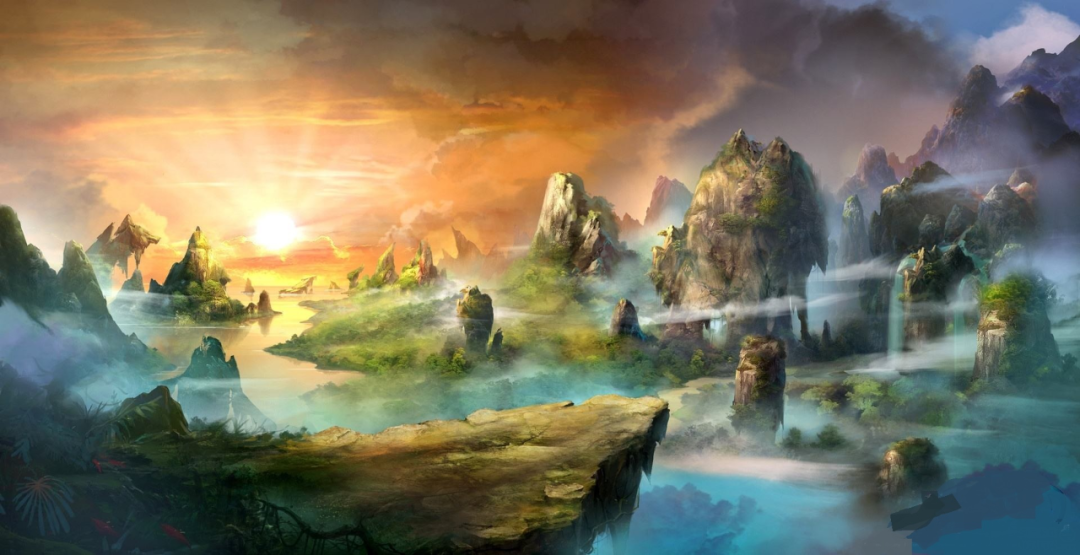Carriages Pulled by Spiritual Beasts
In the middle and late Warring States period, the idea of immortals emerged along with people's fear of death and their longing for immortality. In the Chinese concept of the universe, a new component - the fairyland (the world of immortals) - was also created at that time. After the Han people acknowledged that death was inevitable and immortality was impossible, they finally came to a realization.
They combined the immortality of the soul with becoming an immortal after death and planned an ideal kingdom for another form of life - the spirit and soul. In this way, they could dispel the fear of death and achieve a certain kind of eternal life. This form had already appeared in the form of silk paintings in the Han tombs at Mawangdui in Changsha as early as the early Western Han Dynasty.
However, how to reach the ethereal fairyland (Kunlun) was a big problem. Kunlun Mountain was not easy to reach. It was located in the far west, reaching up to the sky, surrounded by hundreds of rivers. Its abyss was extremely deep and impossible to cross, and the road was extremely long and impassable. Therefore, those who wanted to ascend to immortality and go to Kunlun had to use spiritual beasts to pull their carriages. These mounts that originally lived in the fairyland obviously had their own positioning systems in the fairyland, just like pigeons that can recognize the way and old horses that know the road.
The Immortal Carriage Pulled by Deer
The deer is an auspicious and immortal beast. Many immortals in history preferred to ride deer. For example, Wei Shuqing in "Biographies of Immortals" was in an elegant immortal style when he met Emperor Wu of the Han Dynasty: "He rode on floating clouds and a white deer and gathered in front of the palace hall." In the "Song of the Zhang Gong God Stele" in the Eastern Han Dynasty, there were also lines like "Riding a white deer and following the immortal servant, traveling to the Northern Mountain and communicating with the sky", depicting the situation of an ordinary person driving a three-deer immortal carriage to tour the immortal mountains after death.
The Immortal Carriage Pulled by Crane
There is no need to say much about the crane. Its feathers are simple and pure, its posture is elegant and refined, and its cry is loud and refined. There was a wonderful description in "The Book of Songs": "The crane cries in the marshland, and its sound is heard in the wild. The crane cries in the marshland, and its sound is heard in the sky." People have always believed that the crane symbolizes holiness and elegance.
In "Biographies of Immortals" in the Western Han Dynasty, there was the story of the immortal Prince Qiao riding a white crane. According to the record, Prince Qiao liked to play the sheng to make the sound like the cry of a phoenix. He traveled between the Yi River and the Luo River. He was guided by the Taoist Fuqiu Gong to cultivate immortality on Mount Song. More than thirty years later, he rode a white crane and stopped on the top of Goushi Mountain and then flew away a few days later.
The Immortal Carriage Pulled by Dragon
The dragon, this divine beast, has always been the most ideal mount. It can be big or small, hidden or visible, and is capable of going up to the sky, down to the earth and into the sea without any obstacles in the world. It is the mount of gods and immortals. Qu Yuan expressed the pleasure of riding a dragon to ascend to the sky more than once in his magnificent and imaginative "Chu Ci": "Harnessing four jade dragons and riding on a phoenix-like bird, setting off from Cangwu in the morning."
Of course, the most famous story is that of the Yellow Emperor riding a dragon to ascend to immortality. "After the tripod was completed, a dragon hung down its beard to welcome the Yellow Emperor. The Yellow Emperor mounted it, and more than seventy people from his ministers and harem followed him. Then the dragon flew away." Besides, Xia Houqi also rode a dragon to the Heavenly Court and stole the divine music and returned to the human world smoothly.
Ascending to Immortality by Riding Fish
Emperor Qin Shi Huang and Emperor Wu of the Han Dynasty were obsessed with immortality and wanted to go to the overseas fairyland in the East China Sea. In fact, in the eyes of the Han people, the fairyland and Kunlun overlapped to a certain extent, and the Queen Mother of the West was the key to becoming an immortal.
Therefore, whether it was in the stone reliefs of the Han Dynasty or the murals in the Han tombs, the destination of the fish carriages was always heading towards Kunlun and the Queen Mother of the West. Then, how to ensure that the journey to seek immortality did not deviate from the course? There were four words - The Yellow River originates from Kunlun.
"The Yellow River originates from Kunlun" came from "Records of the Grand Historian - Biography of Dayuan". Even though the people in the Han Dynasty knew clearly that the source of the Yellow River was not in the Western Regions, they still created the theory of "underground flow" and pushed the source of the river westward. The purpose was to regard the mountain where the river originated as the Kunlun that could make people become immortals. In this way, the mountain was no longer ethereal and difficult to find.
So, since the Yellow River originated from Kunlun, as long as we followed the river upstream, we would surely be able to reach the fairyland of Kunlun. In this case, it is not difficult to understand why fish carriages were used. Of course, the most important point is that the environment of the fairyland of Kunlun was too dangerous. "The Classic of Mountains and Seas - Chapter of the Great Wilderness in the West" said: "Around the Kunlun Hill, there is the abyss of the Weak Water."
The Weak Water is so difficult that it is impossible to drink from it, and even a goose feather can't float on it. It is obviously impossible to pass through it by swimming or diving. However, for the koi fish living in the water, it is as easy as breathing. This might be another consideration for using fish carriages.
Of course, ascending to immortality by riding fish is not something strange. In "Biographies of Immortals", there was the story of Qin Gao ascending to immortality by riding a carp:
"Qin Gao, a man from the State of Zhao at the end of the Zhou Dynasty, could play the qin. He was an attendant of King Kang of the State of Song. He wandered between Jizhou and Zhuojun. Later, he made an appointment with his disciples to enter the Zhuoshui River to catch the dragon's son and promised to return on a certain day. When the day came, his disciples waited by the water. Qin Gao really rode a carp and came out. He stayed for a month and then went back into the water."
Because the story of Qin Gao ascending to immortality by riding a carp has been passed down continuously, later generations often used Qin Gao's story to express their strong aspiration to become immortals. For example, as mentioned in "The Finest Blossoms in the Garden of Literature": "I wish to follow Qin Gao's example and ride a fish into the waves", and as said in "The Complete Tang Poems": "Waiting for the crane to come until death, all say they will ride a fish and go."
So, I envy the ancients. They had so many carriages to choose from when ascending to immortality, while I only have a bicycle...



